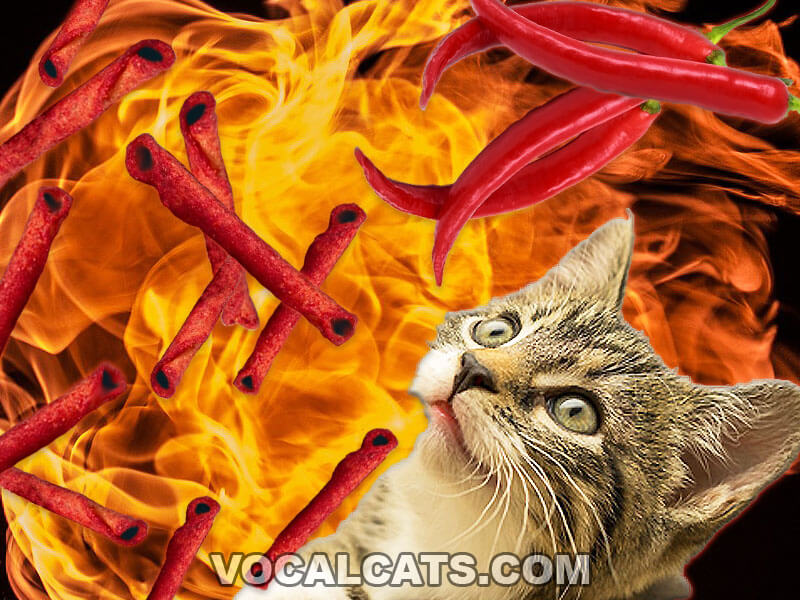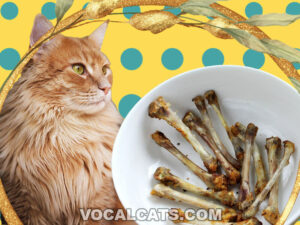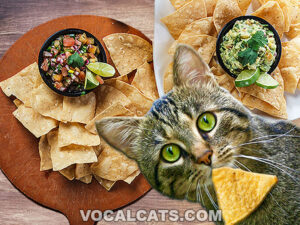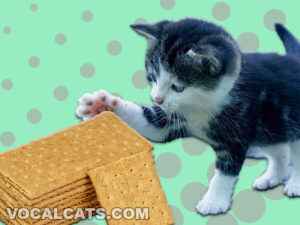Can cats eat Takis? No, cats should not eat Takis because this spicy crunchy snack contains tons of ingredients that are not suitable for feline consumption. Takis are packed full of carbs, sugar, spices, and sodium, all of which are harmful to your cat’s health. High salt consumption can lead to sodium poisoning, too much sugar can lead to upset stomach and diabetes, and corn flour contains carbs that our feline friends don’t need and can cause weight gain.
Takis is a spicy human snack made from cornmeal and chili pepper. Although a few Takis won’t harm your feline companion, an entire bag can pose some serious health risks. These include vomiting, sodium poisoning, diarrhea, extreme thirst, tremors, seizures, or even coma.
The chili pepper in this rolled, corn tortilla chip snack can also burn your cat’s mouth and cause an upset stomach. Keep reading as we’ll discuss what other ingredients in Takis can harm your cat’s health and
Takis contain that’s made from an active component called capsaicin. This irritant will not only upset your cat’s stomach but also burn tissues it comes into contact with.
Contents
- Can cats have Takis?
- Are Takis bad for cats?
- Takis ingredients
- Health risk of Takis on cats
- Do Takis provide any nutritional benefits for your cat?
- What if my cat accidentally ate Takis? What will happen? What should I do?
- Symptoms to watch for
- Treatments if your cat has food poisoning from Takis
- What are some feline friendly and safe non toxic Takis alternatives?
- So, can cats eat Takis?
- Related Questions
Can cats have Takis?
No, cats should not have Takis because, as mentioned above, Takis are spicy and can lead to stomach burn in your cats. They also contain various other ingredients that can be poisonous to your cat if consumed in large amounts, such as salt, sugar, and chili pepper. To know how Takis can affect your cat, let’s see what Takis are in the first place.
What are Takis?
Takis are rolled tortilla corn chips first made in Mexico in 1999 by Barcel, a Mexican company. Four years later, Takis were also introduced in the U.S. They have a spicy, tangy taste and come in five flavors: Nitro, Blue Heat, Fuego, and Crunchy Fajitas.
The name Takis is of Greek origin, and it means All-Holy. However, these ‘All Holy’ Takis can ruin your cat’s digestive system if they overconsume them. Takis are known to cause stomach ulcers and cancer in humans, so it is even worse for cats, whose digestive system is too sensitive even to handle carbs.
What are Takis made of?
Takis are corn chips made from corn flour and vegetable oil. They also include seasonings, such as sugar, salt, citric acid, yeast extract, onion powder, Maltodextrin, soy protein, chili pepper, sodium bicarbonate, natural and artificial flavors, and food dyes.
Are Takis bad for cats?
Yes. Takis don’t contain any nutritional value for cats. As obligate carnivores, cats are supposed to have 70% animal protein in their diet. In contrast, Takis have little to no protein and contain ingredients that can become toxic for your cat if it overconsumes them, such as salt, citric acid, onion, sugar, and yeast extract.
Takis ingredients
Takis Fuego ingredients
- Corn flour that is processed with lime.
- Vegetable Oil including Palm and/or Soybean and/or Canola and/or Rice Bran Oil.
- Seasoning including:
- Salt.
- Maltodextrin.
- Citric Acid.
- Sugar.
- Monosodium Glutamate.
- Hydrolyzed Soy Protein.
- Onion Powder.
- Yeast Extract.
- Red 40 Lake.
- Yellow 6 Lake.
- Natural and Artificial Flavors.
- Sodium Bicarbonate.
- Soybean Oil.
- Chili Pepper (Chile).
- Disodium Inosinate.
- Disodium Guanylate.
- TBHQ (Antioxidant).
Health risk of Takis on cats
Takis pose various health risks for cats. For example, chili pepper in Takis contains a chemical irritant known as capsaicin that burns your cat’s mouth. It also has salt, which is poison for your cat if its amount exceeds 40 mg per day. Sugar is another ingredient that causes diabetes and tooth decay in cats in the long run. On the other hand, citric acid can lead to central nervous depression in cats if taken in an overdose. We’ll discuss each ingredient’s effects on your cat in detail.
Corn flour processed with lime
The primary ingredient in Takis is corn flour. However, corn flour is processed with lime before it can be used to make Takis, and this process is known as nixtamalization. The maize kernels are dried, cooked, and then placed in an alkaline solution made from water and lime (calcium hydroxide). Then, the maize kernels are drained and rinsed with water to remove the pericarp (the outer layer) from the grains. Finally, the maize kernels undergo the milling process to produce a dough used to make the base for Takis, such as tortillas and tamales.
Although this corn flour contains a lot of fiber and nutrition that is good for humans, it still includes a lot of carbohydrates that a cat should consume less of. A cat should have less than 10% carbs in its everyday diet, while 100 grams of corn flour contains 91 g of total carbohydrates. As cats don’t have the enzyme amylase in their liver or pancreas to digest such levels of carbs, cats can suffer from indigestion, vomiting, diarrhea, and lethargy.
Corn flour also has a high glycemic index, which means glucose is released rapidly in the cat’s bloodstream leading to a temporary spike in energy. As this energy wears off after a short while, your cat is again hungry for more food, which can cause feline obesity in the long run.
Vegetable Oil
Salt and Monosodium Glutamate
Salt is toxic for cats and shouldn’t exceed 40 mg daily, or your cat can suffer from sodium poisoning or hypernatremia. This is because it messes with the cat’s electrolyte levels resulting in a plethora of side effects, such as:
- Lethargy
- Vomiting
- Seizures
- Excessive thirst
- Tremors
If cats keep having salt more than the limit prescribed regularly, they can also suffer from some long-term side effects like:
- Incoordination
- Obesity
- Coma
Monosodium Glutamate, also known as MSG, is usually hidden in most pet foods and is only labeled as “Natural Flavoring” or “hydrolyzed protein.” It is a flavor enhancer containing a lot of sodium, which, as mentioned above, is toxic for cats. However, a little MSG won’t harm your cat, so make sure it doesn’t consume an entire bag of Takis. Some short-term side effects of MSG are:
- Vomiting
- Shortness of breath
- Diarrhea
- Lethargy
If consumed regularly in large amounts, your cat can suffer from some serious long-term health issues such as:
- Seizures
- Incoordination
- Obesity
Maltodextrin
Maltodextrin is a type of sugar (polysaccharide) added to food for flavor. It is easy to digest like glucose and looks like white powder. Made from rice, corn, or wheat, Maltodextrin is high in carbohydrates. This means it doesn’t have much nutritional value for cats and only is a source of empty energy due to its high glycemic index (GI).
Citric Acid
Citric acid is found in citrus fruits such as oranges, lemons, and limes, and it is acidic and sour to the taste. A little citric acid won’t harm your cat, but a lot of it can irritate your cat’s central nervous system leading to its depression, seizures, tremors, or even death.
Sugar
Sugar is toxic for your cat if ingested in a large amount. Your cat doesn’t have the enzyme glucokinase that can digest sugar properly and prevent your cat from getting overwhelmed by it. This is also the reason why your cat can’t taste sugar. In the short-term, overconsumption of sugar can lead to diarrhea, muscle tremors, vomiting, and liver damage. In the long run, your cat can suffer from diabetes, tooth decay, kidney failure, and even death.
Hydrolyzed Soy Protein
Hydrolyzed soy protein is when soy protein molecules have been broken down to be small enough so that the cat’s immune system can’t detect them and trigger the alarm for an allergen alert. It is also highly digestible without causing your cat any allergies, such as skin problems. Although hydrolyzed soy protein is suitable for your cat, it can cause diarrhea and taste bitter because of the broken-down protein.
Onion Powder
Onion, in general, is toxic for your cat. It breaks down your cat’s red blood cells, thus cutting off the oxygen supply to other parts of the cat’s body. This leads to anemia as the number of red blood cells drops from the normal range.
Yeast Extract
Yeast is not suitable for cats and shouldn’t be in any of the foods cats consume because once ingested; it rises in the stomach, leads to bloating, and can only be removed through surgery. However, yeast extract is yeast without its cell walls and is used to enhance food flavor. It is also present in cat foods for taste so they can eat it and get the nutrients from food.
Red 40 Lake and Yellow 6 Lake
Both are food dyes that can harm your cat if it is allergic to them. Your cat can have an allergic reaction that includes vomiting, diarrhea, itching, rashes, fever, sneezing, joint pain, redness, anaphylactic shock, or loss of appetite. Regular overconsumption can cause cancer, kidney damage, liver damage, or tumor.
Sodium Bicarbonate
Sodium bicarbonate is nothing but baking soda. It is made from salt, sodium, and bicarbonate. It is toxic for your cat if it consumes more than 1-2 teaspoons daily. This is because baking soda interrupts your cat’s electrolyte levels which causes diarrhea, asthma, disorientation, and dehydration.
Chili Pepper (Chile)
Chili pepper is toxic for cats because it contains capsaicin. This active component is spicy and will burn your cat’s mouth. It also messes with your cat’s digestive system and causes diarrhea, vomiting, and runny nose.
Disodium Inosinate
This is also a food taste enhancer used in synergy with MSG. Disodium inosinate is usually produced from chicken meat and is expensive. Therefore, it exists in food along with MSG or glutamic acid. Because MSG contains a lot of sodium, you should not let your cat consume food that contains MSG or disodium inosinate.
Disodium Guanylate
Disodium guanylate is a type of sodium used as a flavor enhancer. Like disodium inosinate, it is also used in conjunction with MSG or glutamic acid. As salt is toxic for cats, and they can suffer from sodium poisoning, cats should not consume products that contain a lot of salt.
TBHQ (Antioxidant)
TBHQ or tertiary butylhydroquinone is added to food to preserve it and extend its shelf life. However, it is proven that consistent high doses of TBHQ can lead to cancer and DNA damage in cats.
Do Takis provide any nutritional benefits for your cat?
No. Takis contain many flavor enhancers full of sodium, which are toxic for your cat. One Taki that weighs around 2.3 grams includes 1.4 g of carbs and 15.9 mg of sodium. This means most of a Taki is nothing but carbs, while the rest is sodium and fat. Although mono-unsaturated and poly-unsaturated fats are considered ‘good’ fats, they should only incorporate 20% of a cat’s diet. Furthermore, there is 0.2 g of saturated fat in one piece of Takis, which is ‘bad’ fat and leads to obesity and high cholesterol levels. Also, one piece of Takis has 12 calories, which means if a pack of Takis contain 12 pieces, then your cat would be consuming 144 calories in a day with no nutritional benefits.
Nutritional Profile of Takis Fuego (1 Piece or 2.3 grams)
| Name, Unit | Amount |
| Calories, cal | 12 |
| Sugar, g | 0.1 |
| Sodium, mg | 15.9 |
| Carbohydrate, g | 1.4 |
| Total Fat, g | 0.6 |
| Saturated Fat, g | 0.1 |
| Polyunsaturated Fat, g | 0.3 |
| Monounsaturated Fat, g | 0.2 |
| Potassium, mg | 5.2 |
| Protein, g | 0.2 |
| Fiber, g | 0.1 |
What if my cat accidentally ate Takis? What will happen? What should I do?
It wouldn’t be a big deal if your cat munched on a single piece of Takis. It would be fine. Try to keep your Takis away from your cat and give it fresh water. If your entire bag of Takis is empty, take your cat to a vet as soon as possible because Takis are very spicy, and your cat probably has a burned mouth and will be showing symptoms soon.
Symptoms to watch for
Many ingredients in Takis are harmful to your cat. Overconsumption can lead to some obvious symptoms you can watch out for if you’re wondering why your Takis’ bag is empty. These include:
- Vomiting
- Diarrhea
- Asthma
- Fever
- Runny nose
- Dehydration
- Loss of appetite
- Disorientation
- Rashes
- Seizures
- Tremors
- Incoordination
Treatments if your cat has food poisoning from Takis
- Sodium Poisoning: your cat can get sodium poisoning if it eats too many Takis because one bag contains a lot of salt and flavor enhancers that are also types of sodium, such as MSG, disodium inosinate, and disodium guanylate. Take your cat to the vet so they can monitor your cat’s electrolyte levels to form a treatment plan specific to your cat’s situation.
- TBHQ Poisoning: this is known to cause cancer and is very harmful to your cat. Take your cat to the vet asap so they can give you a detailed diet plan and medicine to give your cat.
- Onion Powder Poisoning: Onion is poisonous to your cat. It leads to anemia and prevents your cat from breathing properly due to a shortage of oxygen in its organs. Rush your cat to the vet to give it a constant oxygen supply until the onion is out of your cat’s system.
What are some feline friendly and safe non toxic Takis alternatives?
There are a lot of healthier alternatives to Takis that include:
- Cooked meat, such as chicken or beef
- Fish such as canned tuna
- High-quality cat food
Cats are obligate carnivores and need more animal protein in their diet than they need carbs. That’s why they can survive without vegetables and grains. Therefore, giving your cat cooked or boiled chicken or beef is like giving them the food they can consume best. Chicken also helps keep their heart healthy, while canned fish maintains their sharp vision.
Apart from meat, you should also invest in some high-quality cat food that contains the appropriate amount of fiber, protein, and fat that fulfills the remaining nutritional requirements for your cat.
So, can cats eat Takis?
Takis are a poor source of nutrition for cats. They don’t contain enough protein to make up your cat’s 90% dietary requirement. Neither do they contain ingredients that can be a good source of energy. Takis are high in sodium, flavor enhancers, and carbs. While sodium is toxic for your cat, carbs are almost indigestible and lead to long-term health issues in your cat. Therefore, try to keep Takis as far away from your cat as possible.
Related Questions
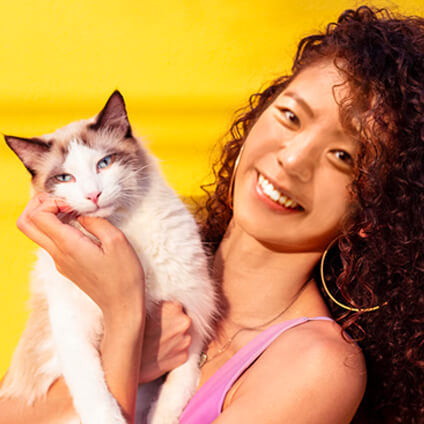
With over five years of specialized experience as an animal writer, my expertise lies in cat nutrition, health, behavior, grooming, and training. I am dedicated to delivering helpful and informative content that caters to the well-being of our feline friends. My primary goal is to empower pet owners with knowledge and ensure our feline companions thrive in health and happiness. In my free time, I love volunteering at local cat rescue centers.
